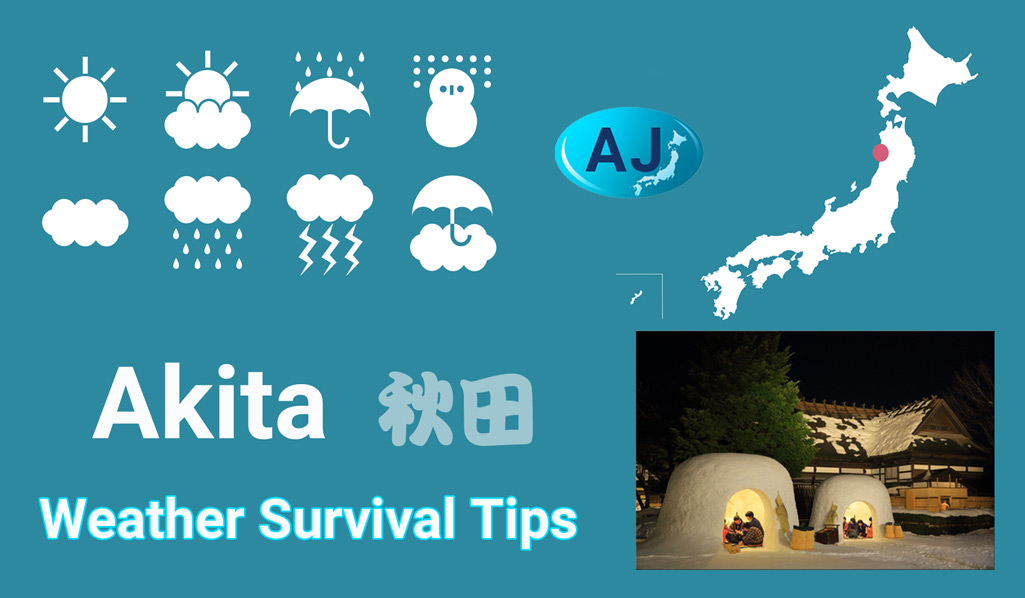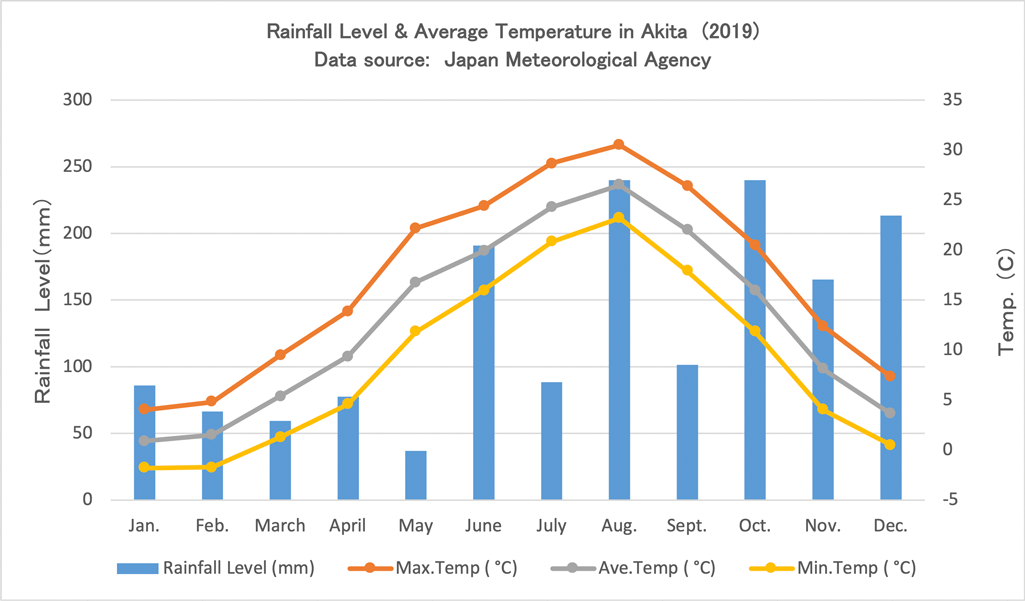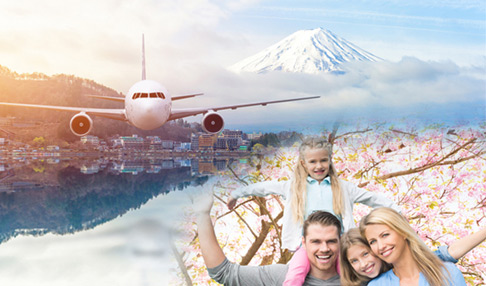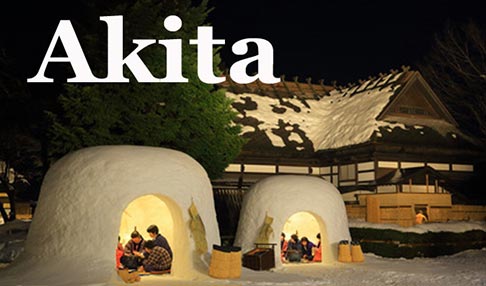Climate & Weather in Akita

For foreign expats moving to Akita City from overseas countries as well as ones moving to Akita City from other areas in Japan, we here provide the guidance on Akita weather. It will make us happy if it can help you to prepare for your seasonal clothing and more for your life in Japan.
Akita City, like most of the rest of the world, has a fair amount of seasonal variation in its weather patterns. It has not so much precipitation and less fallen snow in the winter season than in the other areas on the northeastern Sea of Japan side. The lowest temperature is the same level in Utsunomiya and Mito in the North Kanto region. The spring season begins slightly late in Akita city. It has more fine days than on the Pacific Ocean side in the rainy season while it often has heavy rain fall toward the end of the rainy season. In the summer time there are many fine days and the temperature sometimes rises above 30°C under the influence of the foehn phenomenon and results in hot nights with no less than 25°C. After mid-August it goes into the rainy season by the influence of the autumnal rain front and is also affected by the typhoon season.
Rainfall Level & Average Temperature in Akita (2019)
| Jan. | Feb. | March | April | May | June | July | Aug. | Sept. | Oct. | Nov. | Dec. | |
|---|---|---|---|---|---|---|---|---|---|---|---|---|
| Rainfall Level (mm) | 86 | 66.5 | 59.5 | 77.5 | 37 | 191 | 88.5 | 240 | 101.5 | 240 | 165.5 | 213.5 |
| Max.Temp ( °C) | 4 | 4.8 | 9.5 | 13.9 | 22.2 | 24.4 | 28.7 | 30.5 | 26.4 | 20.5 | 12.4 | 7.3 |
| Ave.Temp ( °C) | 0.9 | 1.5 | 5.4 | 9.4 | 16.8 | 19.9 | 24.3 | 26.5 | 22 | 16 | 8.1 | 3.6 |
| Min.Temp ( °C) | -1.8 | -1.7 | 1.3 | 4.6 | 11.8 | 16 | 20.8 | 23.2 | 17.9 | 11.8 | 4 | 0.5 |

Average Temperature & Humidity in Akita (2019)
| Jan. | Feb. | March | April | May | June | July | Aug. | Sept. | Oct. | Nov. | Dec. | |
|---|---|---|---|---|---|---|---|---|---|---|---|---|
| Ave.Temp ( °C) | 0.9 | 1.5 | 5.4 | 9.4 | 16.8 | 19.9 | 24.3 | 26.5 | 22 | 16 | 8.1 | 3.6 |
| Ave.Temp ( °F) | 33.62 | 34.7 | 41.72 | 48.92 | 62.24 | 67.82 | 75.74 | 79.7 | 71.6 | 60.8 | 46.58 | 38.48 |
| Humidity (%) | 73 | 71 | 67 | 67 | 72 | 75 | 79 | 76 | 75 | 72 | 72 | 73 |
Rainfall is more frequent from July through December, during which includes the late stage of Rainy Season in July and Typhoon peak season in August –September, and the beginning of winter with strong northwest seasonal wind towards December.
It has been really unlike the average data for these past several years that the days of intense heat and higher temperatures are recorded in the summer due to global warming and heat island effects; so the air conditioner is recommended.
Seasonal Clothing (for Akita & Vincinity)
- Spring (Mar. - May):Topcoat, jacket, sweater
- Summer (Jun. - Aug.):Light clothing, short or long sleeves
- Autumn (Sep. - Nov.):same as Spring
- Winter (Dec. - Feb.):Down jacket, wool coat, warm sweater, scarf, gloves
The best times to visit are April-May, for the well-known blooming of cherry blossoms with pleasant climate, and October-November for autumn leaves changing and enjoyable climate. There are many fine days in the rainy season from June. The summer time from July to August brings seldom days over 30℃ resulting in more comfortable days than in Tokyo. The beginning of winter is one month faster than in Tokyo and the winter clothing is required earlier as well. From November snowfall starts to be snow cover and the temperature often drops below 0℃. It is helpful for you to see Seasonal Clothing idea above.
The Weather in Akita and Advice for Every Season
Akita is a big city and most people get around using public transit, bikes, or their feet. Here are a few tips & tricks to make surviving close encounters with Mother Nature a little easier:
■ Precipitation
Always check the forecast before you leave for the day and pack an umbrella if rain is predicted.
It’s no fun being caught in a downpour and waiting under the corner of a ramen shop’s roof waiting for the rain to pass.
o Pro tip: If weather forecasts aren’t to your liking, stick your head outside before you leave for the day and see if others are carrying umbrellas and follow their lead. If you do get stuck in the wet, you can always duck into the nearest convenience store for a cheap umbrella—they’re everywhere!
■ Snowfall
About how to choose shoes and the tip about how to walk on snow-covered roads, ask you colleagues in your workplace or gather information by visiting to local information website.
o Pro tip: The most recommended shoes are high rubber rain boots. Tips about how to walk on snow-covered road is to walk slowly by pressing your whole feet on the ground with small step sizes.
■ Heat
It can get quite hot in Akita so dress accordingly. Akita is a concrete jungle that displays the "heat island" effect common in big metropolitan areas.
o Pro tip: If you’re going to work, check and see if your office follows a "cool biz" dress code which is a set of comparatively relaxed dress guidelines encouraged by the Japanese government to help make life more comfortable for office-workers in the summer.
■ Cold
It can get quite freezing in Akita so dress accordingly such as a layered wearing. There are so many days with the temperature below 0℃ in Akita winter.
o Pro tip: If you’re going to work, check and see if your office follows a "warm biz" dress code which is a set of recommended guidelines encouraged by the Japanese government to help make life more comfortable for office-workers in the winter.






